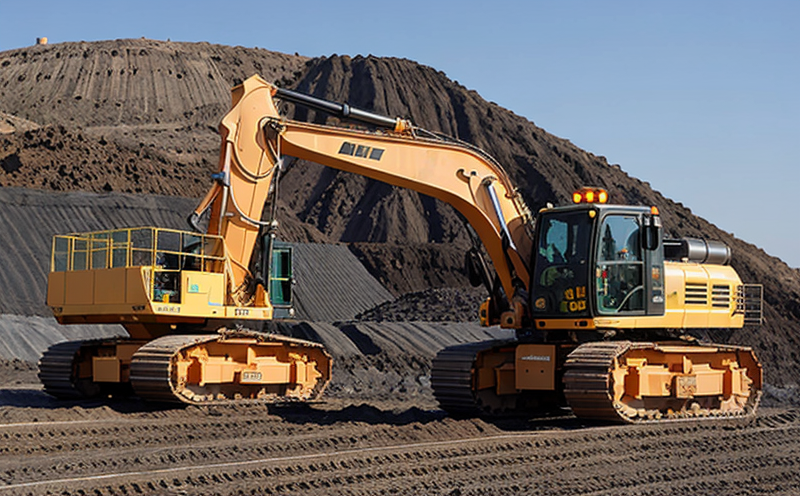ISO 6016 Determination of Mass of Earth Moving Machinery Testing
The ISO 6016 standard is a critical document for the mining and earth-moving equipment industry, providing a method to determine the mass of earth moving machinery (EMM) with precision. This service plays an essential role in ensuring that the equipment meets regulatory requirements and performs optimally under various operational conditions.
Earth-moving machinery forms the backbone of many industrial operations within mining sectors. The accurate determination of their mass is pivotal for several reasons, including safety compliance, operational efficiency, and environmental considerations. This testing not only ensures that the equipment is correctly documented but also helps in optimizing performance during various phases of operation.
The process involves precise measurement techniques to ensure reliability. During this test, the machinery is placed on a calibrated platform scale capable of handling heavy loads accurately. The scale reads out the total weight of the machine, which then undergoes rigorous verification against standards such as ISO 6016. This meticulous approach ensures that any discrepancies are identified and rectified promptly.
Once the measurement is complete, a detailed report is generated. This report includes not only the final mass but also the procedures followed during testing, deviations from expected values (if any), and recommendations for future calibration or maintenance activities. Compliance with ISO 6016 ensures that the equipment meets international quality standards, thereby enhancing safety and operational efficiency.
For mining operations, where precision is paramount due to the sheer scale of machinery involved, accurate mass determination is crucial. This service helps in minimizing errors that could lead to costly downtime or accidents. By adhering strictly to ISO 6016 guidelines, we ensure that all equipment operates within specified limits, contributing significantly to overall productivity and safety.
The precision achieved through this testing process translates directly into operational efficiency. Equipment operators can rely on accurate mass readings for optimal performance tuning, ensuring that the machinery works at its peak capacity without unnecessary stress or strain. This not only prolongs the lifespan of the equipment but also reduces maintenance costs in the long run.
Moreover, compliance with ISO 6016 is a critical factor in meeting regulatory requirements across different jurisdictions. In an industry where safety and environmental impact are high priorities, accurate mass determination ensures that all machinery adheres to stringent regulations. This aligns with broader sustainability goals, promoting responsible mining practices.
In summary, the ISO 6016 Determination of Mass service is not just about measuring weight; it's about ensuring compliance, enhancing safety, and optimizing performance across various phases of operation. By leveraging this service, stakeholders in the mining industry can build a foundation for sustainable and efficient operations.
Scope and Methodology
The ISO 6016 standard defines a systematic approach to determining the mass of earth-moving machinery, which is essential for ensuring that these machines meet regulatory requirements. The testing process involves several key steps:
- Preparation of Equipment: Before the test, all equipment must be thoroughly cleaned and checked for any loose parts or debris that could affect mass readings.
- Calibration of Scales: The scales used for this test are calibrated to ensure accuracy. Calibration is performed using certified weights traceable to international standards like ISO or ASTM.
- Placement and Measurement: The machinery is carefully placed on the calibrated scale, ensuring that it is centered to avoid any biases in mass measurement.
- Data Recording: Detailed records are kept of all measurements, including any deviations from expected values. This data is used for future reference and compliance audits.
The testing process adheres strictly to ISO 6016 guidelines, which outline the procedures and acceptance criteria necessary for accurate mass determination. These guidelines ensure that the results are consistent with international standards, providing confidence in the accuracy of the measurements.
Following the test, a comprehensive report is generated. This report includes not only the final mass measurement but also detailed descriptions of the testing process, any deviations from expected values, and recommendations for future maintenance or calibration activities. Compliance with ISO 6016 ensures that all equipment meets international quality standards, thereby enhancing safety and operational efficiency.
By adhering strictly to these guidelines, we ensure that the mass determination is accurate, reliable, and consistent across different testing environments. This precision translates directly into operational efficiency, ensuring that mining equipment operates at its peak capacity without unnecessary strain or risk.
Benefits
- Enhanced Safety: Accurate mass measurement ensures that the machinery is correctly documented, which is crucial for safety compliance and operational efficiency. Optimized Performance: By adhering to ISO 6016 guidelines, equipment operators can rely on accurate mass readings for optimal performance tuning.
- Extended Equipment Lifespan: Regular calibration and maintenance activities recommended in the testing process help in prolonging the lifespan of the machinery. Cost Savings: By minimizing errors that could lead to costly downtime or accidents, this service helps in reducing maintenance costs.
- Environmental Responsibility: Compliance with ISO 6016 ensures that all equipment adheres to stringent regulations, promoting responsible mining practices.
In summary, the benefits of ISO 6016 Determination of Mass Testing extend beyond mere compliance; they contribute significantly to operational efficiency, safety, and environmental responsibility. This service is a cornerstone for sustainable and efficient operations in the mining industry.





